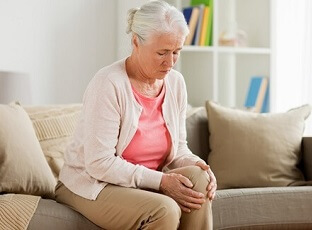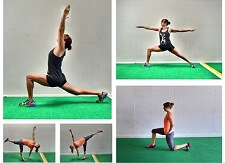- Home
- Knee Pain Treatment
- How To Improve Flexibility
Knee Flexibility
Written By: Chloe Wilson, BSc(Hons) Physiotherapy
Reviewed by: KPE Medical Review Board
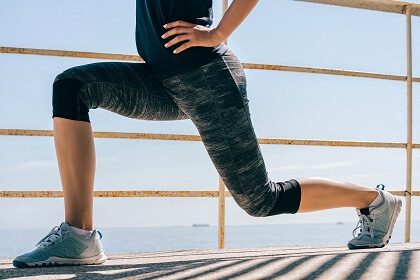
Knee flexibility, or should I say inflexibility, is a common problem that affects people of any age.
There may be long-standing muscle tightness, problems following a knee injury or even restriction in the joint. Any of these can lead to knee pain, swelling, instability and decreased function.
Here, we look at the most common causes of knee stiffness and tightness, and will share with you loads of great tips for how to improve knee flexibility.
What Causes Restricted Knee Motion?
Reduced knee movement is often due to a combination of:
- Muscle Tightness: Passive muscle tightness - due to shortening in muscle length, active muscle tightness - due to muscle spasms
- Joint Stiffness: restriction of joint movement
- Muscle Weakness: lack of strength, control and endurance
- Pain: knee pain can inhibit movement
- Injury: Damage to structures in and around the knee
- Swelling: Excess fluid in the knee restricts movement
Learn more about the Causes of Knee Stiffness >
How To Improve Knee Flexibility
There are lots of different ways to improve knee flexibility depending on what is causing your restriction.
Here some suggestions of things that can help, but if your knee movement is limited, you should get checked out by your doctor.
1. Exercises
One of the most popular and effective ways to improve knee flexibility is exercises. These may include a combination of:
- Strengthening Exercises: to increase muscle strength and endurance LEARN MORE >
- Resistance Band Exercises: a slightly different twist on traditional strengthening exercises LEARN MORE >
- Mobility Exercises: to improve knee range LEARN MORE >
- Knee Stretches: to increase muscle length. May be active or passive LEARN MORE >
- Stability Exercises: improve balance, posture and control LEARN MORE >
Correct Stretching Technique
Stretches are the most commonly used too for improving knee flexion and typically focus of changing the length of a musculotendinosus unit i.e. increasing the distance between a muscles points of origin and insertion. Stretches also help reduce the tension through a muscle.
Static stretches are used most commonly, where a muscle is held under tension at the point where a stretching sensation is felt in the muscle. This position can be held by the individual or a partner and should be repeated.
There is lots of different information out there about the best ways to stretch, but research shows that the most effective way to improve knee flexibility with stretches is to:
- Stretch To The Point Of Discomfort: but don’t push in to pain
- Hold for 30 seconds
- Repeat 3 times
- Stretch at least 3 times a week
- Stretch After Exercising: muscles stretch better when they are warm
You should focus on stretching both the knee muscles and hip muscles.
2. Keep Active
Our joints are designed to move and our muscles are designed to be used. If we don’t keep active, then joints get stiff and muscles get weak and tight which can lead to knee problems.
Regular exercise helps to:
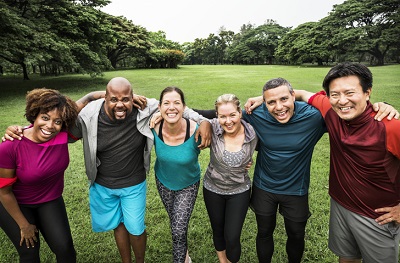
- Reduce joint stiffness
- Reduce the risk of osteoporosis
- Lower risk of falls
- Reduce blood pressure
- Reduce stress
- Manage weight
- Lower cholesterol
- Lower pain levels
- Strengthen bones, muscles and joints
- Improve wellbeing: including mood, sleep, relaxation and energy
- Lower the risk of diseases: such as type 2 diabetes, cardiovascular disease and some cancers
Government guidelines recommend:
- Do Something Daily: Be active on all, or at least most, days of the week
- Aim For At Least 30 minutes: of moderate exercise or 20 minutes of vigorous exercise at least 4 or 5 times a week
- Start Slow: some activity is way better than no activity. If you don’t any exercise at the moment, start by doing some and gradually build up to the recommended amount.
- Follow the 10% Rule: Increase activity levels by a maximum of 10% each week so you don’t over-strain your body. This might be the duration, distance of exercise depending on what you do.
If you are finding it difficult or painful to get up and down stairs, there are some really simple things you can do to help - check out this article on How To Beat Knee Pain On Stairs
3. Rest It Right
The position that you sit or lie in can have a big impact on knee flexibility. Whether you are sitting down for long periods because you have an office job, have a sedentary lifestyle or are ill or infirm, sitting down for long periods with your knees bent can lead to:
- Knee stiffness
- Hamstring tightening
- Hip flexor tightening
- Lack of knee extension
- Knee, foot and ankle swelling
But, there are some simple things you can do while sitting to improve knee flexibility:
- Raise Your Legs: Sitting with one or both legs stretched out resting on a chair/stool, ideally with your feet at hip level, helps to improve knee extension and reduce knee, foot and ankle swelling
- Support The Knee: Most of the time, you want to have the knee supported e.g. with a pillow so you can rest comfortably but make sure the knee is as straight as possible. This helps stretch the knee out and let’s excess fluid drain out of the feet, ankles and knees to reduce swelling.
- Let Gravity Help: If you are lacking those last few degrees of knee extension, try taking away the support under your knee for short periods allowing your knee to hang freely so gravity pulls it down further into knee extension. Limit this to around 10 minutes every hour or so otherwise your knee may feel stiff and sore.
- Standing Desks: these let you easily transition between sitting or standing when working without having to move all your things, and makes it much easier to set the height just right for you. Changing position every couple of hours or so will help improve knee flexibility, get your muscles working, improve your posture and can also help with concentration. You can get electric ones or crank handle ones of all different sizes.
4. Use Heat
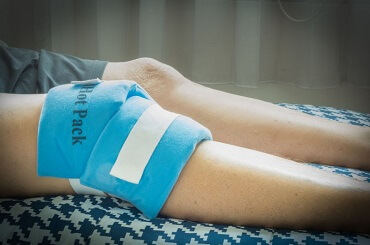
Applying a heat pack to the knee can help improve knee flexibility and reduce pain. Heat increases blood flow to the area bringing in fresh oxygen and nutrients to the joint.
Heat is also a natural analgesic and can feel really soothing as well as helping your muscles to relax, thus improving knee range of motion.
Use a heat pack or hot water bottle (with a cover on) and mold it around your knee leaving it in place for 10-20 minutes at a time.
Safety Information: do not use heat if you have had a recent knee injury or surgery as it can increase inflammation, or if you have any problems with circulation or decreased sensation. Take care not to burn yourself.
5. Oil Your Joints
The knee joint contain a substance called synovial fluid which works as a natural lubricant. Think of it like the oil in your car. It helps the knee to move freely, reducing friction between the bones. This natural lubricant is produced when we move.
Keeping the knee still for long periods slows the production of synovial fluid and the joint can start to dry out. This is one of the reasons why knee pain is often worse first thing in the morning or after sitting down for long periods. Many people find that when they first get up, the knee feels very stiff and sore. But once they’ve been moving around for a few minutes and the dried out joint starts producing more synovial fluid, the knee actually eases up and knee flexibility improves.
So, to help avoid those stiff painful first steps, spend a couple of minutes, before getting up, simply bending and straightening your knee through a comfortable range. Get the fluid pumping in to the joint so it is nice and lubricated before you get up. You’ll be amazed what a difference it can make to your knee range of motion and pain.
6. Hydrotherapy
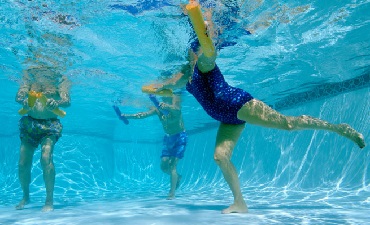
Doing exercises in water can really help improve knee flexibility and strength. Ideally, you want to be in a hydrotherapy pool where the water is warmer (33-36o) than a normal pool, but if you don’t have access to one, use your local pool.
Hydrotherapy can really help with knee pain and stiffness as the water:
- Supports Your Weight: so there is less force going through your joints as you move. People often find they can do things in the pool that they can’t do on dry land
- Provides Resistance: pushing against the water helps to improve muscle strength. Faster movements will work the muscles harder than slower movements
- Reduces Pain: the warmth helps to relax muscles and ease pain
Here are some ideas of things you can do in a pool that can help improve knee flexibility:
- Walking: forwards and backwards
- Jogging On The Spot: can mix with walking e.g. run for 30 seconds, walk for 30 seconds etc
- Side Stepping: Face the wall and step sideways alternating directions
- Lunges: take over-sized steps forwards, backwards and sideways
- Standing Exercises: such as squats, knee bends, knee lifts and hip extensions or any other home exercises you usually do
- Steps: If there are steps (mini stairs rather than a ladder!) practice going up, down and sideways
7. Massage
Massage can be used to increase knee flexibility, increase range of movement and improve performance. Common causes of reduced knee flexibility include muscle overuse, tightness, tension, spasms and inflammation.
A range of massage techniques can be used to help improve knee flexibility:
- Therapeutic Massage: focuses on the superficial layers of soft tissues to encourage relaxation and loosening of the muscle e.g. long strokes
- Deep Tissue Massage: working deeper on the muscles to improve elasticity and breakdown/realign collagen fibres e.g. myofascial release
- Sports Massage: intense massage using a range of pressures, increasing tissue temperature and improving blood flow e.g. kneading
Knee massage can also have the added bonus of improving relaxation which can help to reduce stress and anxiety, which can reduce pain levels.
8. Medication
Pain affects our body’s ability to move. Our natural reaction is that if something hurts, we avoid doing it, but pain is not the same thing as damage. Think of a paper cut – it can really, really hurt, but there is very little actual damage. Pain can be our body’s way of checking with us that we really do want to do something.
People often worry that taking painkillers or anti-inflammatories might mean they do something they shouldn’t, and mask warning signs of further damage. But this is not the case - our bodies are cleverer than that!
It is really important to get knee pain under control so that you can get the joint and muscles moving. It is much better to take medication regularly to reduce pain levels and inflammation so you can increase your activity levels and do exercises to improve knee movement and strength. If you are doing something that really is putting your knee at risk, your body will tell you!
- Talk To Your Doctor: If pain is limiting your knee movement or daily activities, talk to your doctor. They will be able to advise you on what medications are most appropriate for your situation
- Take Medication Regularly: Pain relief is much more effective when taken regularly at the recommended intervals. This helps keep pain levels under control rather than going through peaks and troughs. If you delay taking your next dose until you feel pain, it will take much longer for the pain to reduce than if you hadn’t let it build up in the first place
- Time Your Activities With Your Medication: Think about when you are going to exercise. Give your body time for the effects of painkillers to kick in before doing exercises or more strenuous activities and don’t wait until the next dose is nearly due when the effects are starting to wear off. Plan your day.
9. Joint Mobilizations
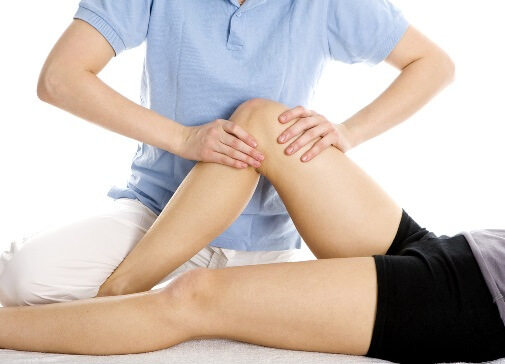
Joint mobilizations are manual techniques performed by a physical therapist to get a joint moving which helps:
- Reduce stiffness
- Reduce pain
- Increase range of motion
- Increase function
When the knee moves normally, it doesn’t just bend and straighten. The knee joint also needs to be able to roll, spin and glide to allow it to move freely, fully and smoothly. These are much smaller, more subtle movements but are essential for full knee range of motion.
Knee stiffness is often linked to restricted roll, spin and glide movements at the joint. Joint mobilizations help to restore these movements to improve knee flexibility and focus on attaining full, pain-free joint motion. Joint mobilizations should only be carried out by an experienced physical therapist and are most effective when combined with a home exercise programme.
10. Anti-Inflammatory Diet
If your knee pain and stiffness is linked with inflammation, changing your eating habits may help. It won’t be a magic cure, but diet can help reduce the frequency and intensity of knee flare-ups. And the good news is that anti-inflammatory foods are really healthy too!
Research has shown that the following foods can help to reduce inflammation and may therefore help to improve your knee flexibility:
- Green & Red Fruits & Vegetables: Leafy greens that are rich in vitamin K, such as kale, cabbage and spinach, broccoli and peas. Dark red fruits such as raspberries, blackberries and cherries – their colour pigment helps to reduce inflammation
- High Fibre Foods: wholegrains such as brown rice, whole-wheat bread and oatmeal
- Beans: high in fibre and anti-oxidants e.g. soybeans
- Herbs & Spices: turmeric, garlic and celery
- Oily Fish: that are high in omega-3 fatty acids such as sardines, tuna & salmon
- Healthy Fats: Nuts (just one handful per day), avocado and olive oil
You should also avoid the following foods:
- Food High in Saturates: such as processed foods like hot dogs
- Full Fat Dairy Products: such as whole milk, cheese and butter. Switch to low fat options to ensure you are getting enough calcium
- Sugary Sweet Treats: cakes, cookies, sweets and fizzy drinks because sugar tells the body to release cytokines which cause an inflammatory reaction. Switch to plain popcorn instead
- Fried Foods: e.g. French fries, fried chicken, donuts and traditional English fish and chips
- Trans Fats: aka partially hydrogenated oils should be avoided completely e.g. some margarines, coffee creamers, biscuits and sweets
11. Steroid Injections
Corticosteroid injections can help to reduce joint pain and inflammation, so your doctor may recommend them to help improve your knee flexibility.
Knee injections are a great way to target fast-acting medication to a precise area often making them more effective than oral medication, and they tend to have fewer side effects.
A small amount of cortisone combined with local anaesthetic is injected into the knee joint. Effects are often felt almost immediately but there are a few possible side effects to be aware of. LEARN MORE >
12. CPM Machine
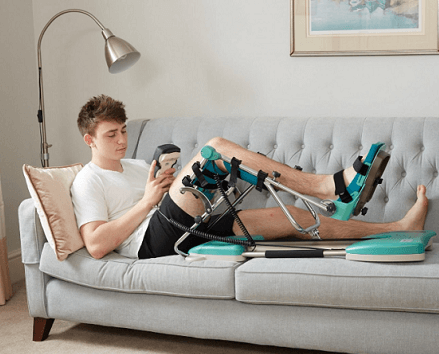
If you are recovering from major knee surgery, such as a knee replacement or ACL reconstruction, then your surgeon may encourage you to use a CPM machine to help improve knee flexibility, particularly flexion.
CPM stands for Continuous Passive Motion and is a device that slowly, repetitively bends and straightens your knee. Your muscles are relaxed with the machine doing all the work.
The CPM can be set to move between different ranges of flexion and extension, so you can gradually increase the knee motion range by changing the settings.
CPM’s are most commonly used to get the knee moving immediately after knee surgery to help reduce post-operative stiffness and the build-up of scar tissue. Patient’s often like them because it gives them the feeling that they are doing something, even when resting and it can give them more confidence to move their knee.
Using a CPM after knee surgery e.g. total knee replacement has been show to improve knee movement in the first few days and weeks of recovery however there is no evidence of any longer-term benefit. There is also the chance that CPM use encourages people to stay in bed rather than being more active with their therapy.
13. PNF Stretching
PNF stands for proprioceptive neuromuscular facilitation and is a special type of progressive stretching involving contracting and relaxing muscles.
PNF uses the body’s inbuilt reflexes to aid stretching. Whilst it has been shown to be one of the most effective ways to stretch, to do it properly you need a partner to help you which can make it impractical.
- Contract Relax: Take muscle to full stretch and then resist movement away from that position.
- Hold Relax: Take the muscle to full stretch and then resist further movement in the same direction.
- Hold Relax Agonist Contract: Similar to hold relax but after resisting further movement actively increase the stretch
PNF stretching should be taught by a physical therapist to ensure appropriate and correct technique so you can safely improve your knee motion range.
How To Track Your Flexibility
The best way to keep track of the progress you are making with knee flexibility is to measure the range of motion at your knee. This is really simple to do, either with a specially designed protractor known as a goniometer, or there are some other quick ways to measure without the need for any equipment.
In the knee range of motion section you can find out everything you need to know about how to measure the flexibility in your knee, how much movement you should be aiming for and what things can restrict flexibility.
If you are trying to improve your knee flexibility through exercises and physical therapy, aim to check your range of motion no more than one or twice a week.
It takes time for knee range of motion to improve so if you measure it too often, you are unlikely to notice much change which can be very disheartening.
10 Second Summary
There are lots of possible causes of knee stiffness and reduced knee motion range.
The best ways to improve knee flexibility are:
- Exercises: knee strengthening and stretching exercises
- Keeping Active and Resting Right
- Regular Hot Packs
- Natural Joint Lubrication
- Water-based Exercises aka Hydrotherapy
- Massage & Joint Mobilisations
- Medication & Injections
- Changing Your Diet
- Knee Motion Machines
Related Articles
References
1. Database of Abstracts of Reviews of Effects (DARE): Quality-assessed Reviews. Therapy interventions for improving joint range of motion: a systematic review. SL Michlovitz, BA Harris, and MP Watkins. Review published: 2004.
2. Saudi Journal of Sports Medicine. Extended sitting can cause hamstring tightness. G Fatima, M Mustafa Qamar, J Ul Hassan, A Basharat. 2017
3. Australian Government Department of Health. Australia's Physical Activity and Sedentary Behaviour Guidelines and the Australian 24-Hour Movement Guidelines. 2019
4. Internation Journal of Sports Physical Therapy. Current Concepts In Muscle Stretching For Exercise And Rehabilitation. P Page. 2012
5. Journal of Physiotherapy. Strength training alone, exercise therapy alone, and exercise therapy with passive manual mobilisation each reduce pain and disability in people with knee osteoarthritis: a systematic review. MJ Jansen, W Viechtbauer, AF Lenssen, EJM Hendriks, RA.de Bie. 2011
6. VeryWell Health. CPM Machine After Knee Replacement. J Cluett. 2020
Last Updated: September 30th, 2025
Next Review Due: September 30th, 2027
